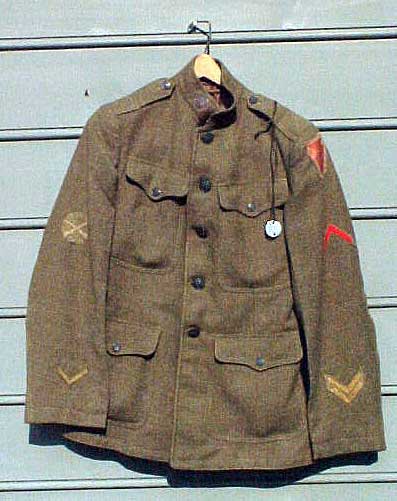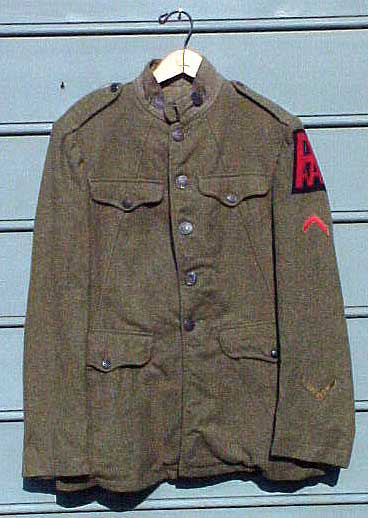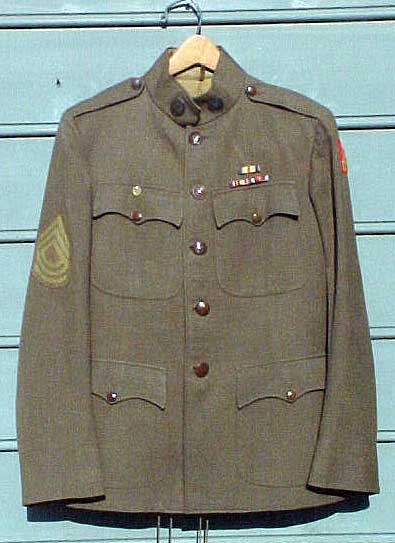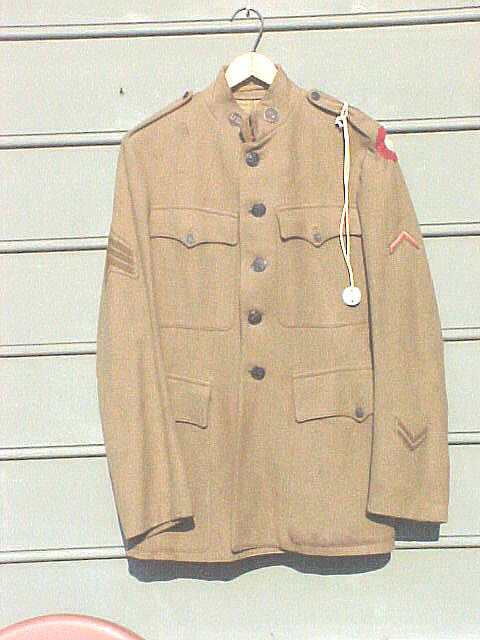 |
Blue Wool Army Uniform Coat: Post Civil War through 1898. Until the Spanish American War the US Army blue wool uniform was the issue for all seasons. As part of the redesign effort spawned by our military campaigns in tropical areas a complete redesign effort was mounted. Although the traditional army blue uniform was slated to be slowly phased out, they were still in issue in many areas through 1910. The legacy of Army Blue lives on, in the current day dress uniform worn by officers and enlisted. Five bright raised shield US eagle buttons were used to close the coat.. It had a rolled falling open collar. and no external pockets. The jacket had a standard cuff fixed with three small bright eagle buttons that had no purpose other than decorative. It also had a and a band of stitching nearly three inches above the cuff. The jacket was fully lined with a black cotton liner and included a single interior breast pocket. There were no shoulder tabs and seams were single sewn. The jacket was constructed of blue wool and most surviving specimens seem to be of a standard color. This uniform is part of a group worn by Pvt. George C. Hupp, from Standardsville, VA who served in the US Cavalry from 1898 until 1913. |
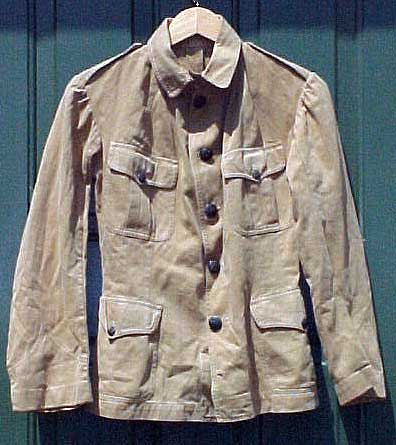 |
Cotton Coat: Circa 1903. In 1902 the US Army began its program of modernizing its uniforms. The development program consisted of a series of changes and modifications at first to the tropical uniforms. A major change to the summer uniform was outlined in General Order 81 of July 17, 1902. The uniform was described as being of cotton or light canvas and buttons would be of dull finished bronze. It had a rolled falling open collar. Specification No. 631 of 1903 further changed the uniform further by describing four patch pockets, the breast pockets as "choked bellows",. The jacket had peaked cuffs and was unlined and had no interior pockets. Shoulder tabs would be of the same material as that of the rest of the uniform and sewn attached at the shoulder. Sleeves were almost tufted at the top and the coat was made of a lighter 71/2 to 8 oz cotton fabric. Surviving specimens exhibit substantial variations in the khaki color. Possibly due to fading over the years but there were consistent attempts to standardize the color used as well as the fade resistance of the material used in construction. Pvt. George C. Hupp uniform group. |
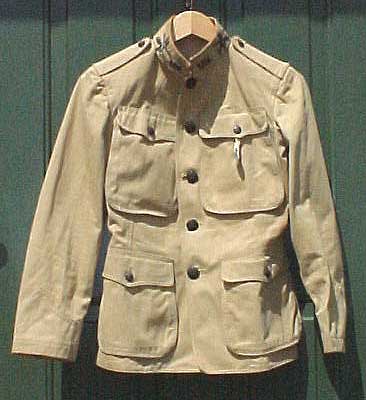 |
Cotton Coat: Circa 1906. In 1906 the Quarter Master General reported that a British military tailor had been engaged to improve the pattern but not the style of the uniform. The result was the adoption in December 1906 of the folded over standing collar , full bellows pockets , a heaver weight and lighter color of cloth and a cut out tail in the rear bottom hem of the jacket. The uniform retained the peaked cuff's, the darkened bronze buttons and had no liner. Pvt. George C. Hupp uniform group. |
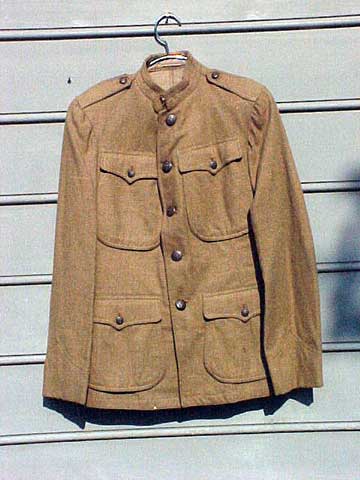 |
Wool Uniform Coat, Circa 1906, It is constructed on the same basic pattern as the 1904-1906 cotton uniform coat except it is made of olive drab to khaki or tan color wool. The uniform coat has 4 patch bellows type pockets with flaps and tapered shoulder tabs all secured by small subdued rimless eagle buttons with national seal. The uniform also uses 5 subdued larger rimless eagle buttons with national seal to close the coat. The coat has a folded or rolled collar, (at times modified to standing). It also has peaked cuffs, and reinforced armpits, inside breast slit pocket and a full cotton liner . The back of the coat has a 3-inch slit on each side of the tail to relieve stress when sitting. All seams are double sewed. It is fixed with a QM tag in the bottom hem and date of manufacture (1909) for this example. |
 |
Cotton Coat: Circa 1911 (1910). The first major change in the Army cotton uniform was with Spec 1126 dated August 1911. This called for an all-new uniform coat without the bellows pockets, rather having 4 patch pockets with flaps secured by small subdued national seal eagle buttons. Standing collar, some having button hole sewed in neck for collar devices on each side. It was closed by 5 rimmed and also issued with rimless subdued national seal eagle buttons attached via split rings. The coat had plane cuffs with double row of stitching about 3in from the bottom of the sleeve. The coat is unlined without interior pockets . It was constructed of olive drab 6.5 to 7 oz material and all seams are double stitched. They are found dyed in a variety of khaki colors from light tan to almost brown, tending toward lighter shades. Tapered shoulder tabs secured by two rimless subdued eagle buttons with national seal. They were in service through 1919. Uniform of James A. Wilson, Co. H, 116th Inf. 29th Division from Hopewell, VA |
 |
Wool Uniform Coat, Circa 1912, Following on the change in the Army cotton uniform of 1911 a wool version was also constructed. At times called the Circa 1916 it conformed with Spec 1126 dated August 1911. Constructed with a Tan rather than an Olive Drab color and of higher quality wool than is found in later uniforms. The coat was without the bellows pockets as well as the folding collar and peaked or pointed cuffs. It had flat patch pockets, plain cuffs with two rows of stitching about 3in from cuff. It had a straight standing collar with one collar disk on each side. The seat slit was eliminated and the coat was fully lined . It had tapered shoulder tabs. Both the coat and the pockets were secured by both rimmed and rimless subdued eagle buttons with national seal. Uniform of Roy Davault, MG Company B. 131 MG Bat. 36th Division, Texas. |
